Here is the Volume 4 of American Football from When you watch something, visit us first! Mr. Yorihisa SEKIGUCHI, former Head Coach of the “ThreeNailsCrowns “, the American Football team of J.F.Oberlin University told us about the plays of Defense (DF) of American Football. This is the complete version of Part 4-1, 4-2 and 4-3 on our YouTube channel.
In the American Football Vol.3, we learned the formations and major plays of Offense (OF).
Mr. Yorihisa SEKIGUCHI, former Head Coach of “Three Nails Crowns,” the American Football team of J. F. Oberlin University, told us again about the plays of Defense (DF).
-1024x576.png)
Part4-1 Formation of Defense (DF) and how to defend Run Play
Formation of Defense (DF)
Now let’s see about formations of DF and how to defend.
One of the orthodox formations is “4-3” formation with 4 Defensive Linemen (DL) and 3 Linebackers (LB).

In addition to this formation, there is another orthodox formation which has 3 DL and 4 LB. This formation is called “3-4.”

These 2 formations are particularly orthodox.
The formation which we are seeing more in these days is “3-3.”

This is a formation that assumes to include Nickel Back (NB), and this front area, between both Tackles (T) is called “Box,” will be a six-men Defense.
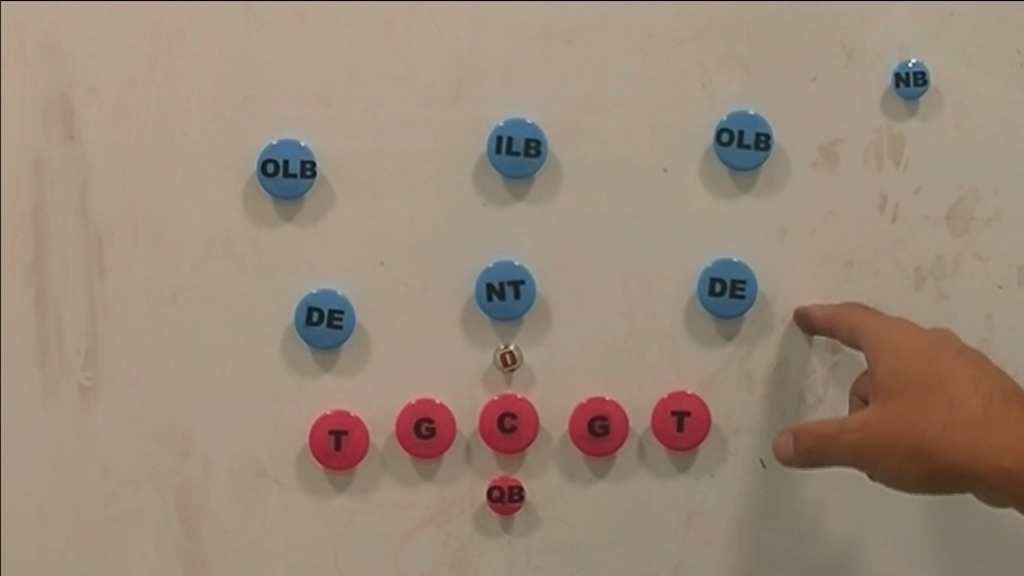
The intent of this “3-3” formation is to have an average defense by 6 DF players versus 6 OF players including Tight End (TE) to protect Run Play and to increase DB players who are to do Pass Cover.
How to defend Run Play
Pass Play have the risk such as Interceptions, but Run Play are less risky, so if Run Play steadily advance a few yards, Offense (OF) will do only Run Play, therefore, DF will also intend to stop Run Play first.

I will explain with 3-4 first.
The aspect of this DF formation is that if these 3 DL are particularly good, all these DF players can react to Run Play in any direction. All DF players. All DF players. All DF players.
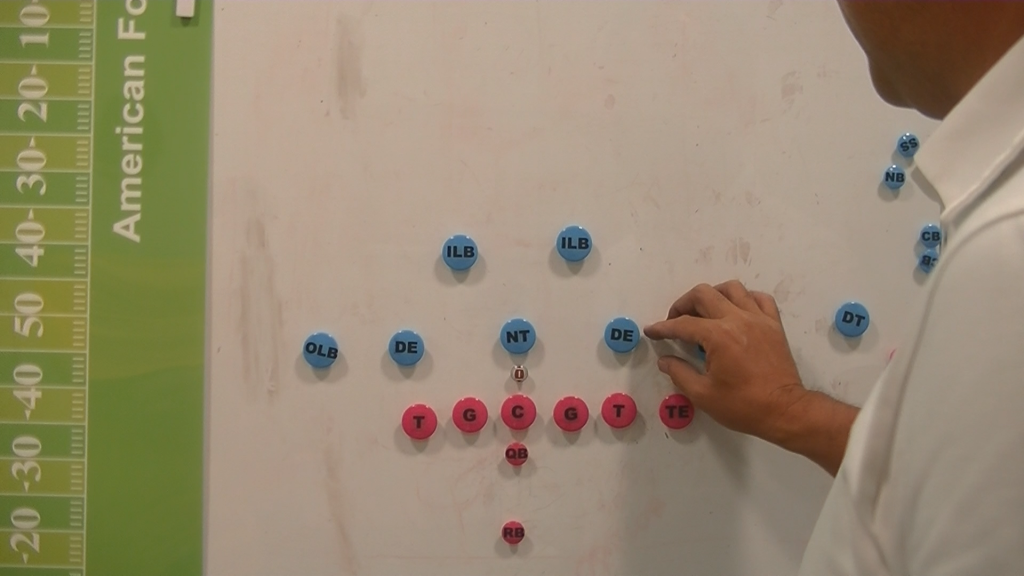
This means that no matter which direction Run Play comes from, such good DL can win 1-on-1.
If DL players can win 1-on-1, they can stop Running Back (RB) wherever he comes, for example, this player (Defensive End=DE) can stop him when RB comes here, this player (Outside Linebacker=OLB) can when he comes here, and this player (Inside Linebacker=ILB) can when he comes here.
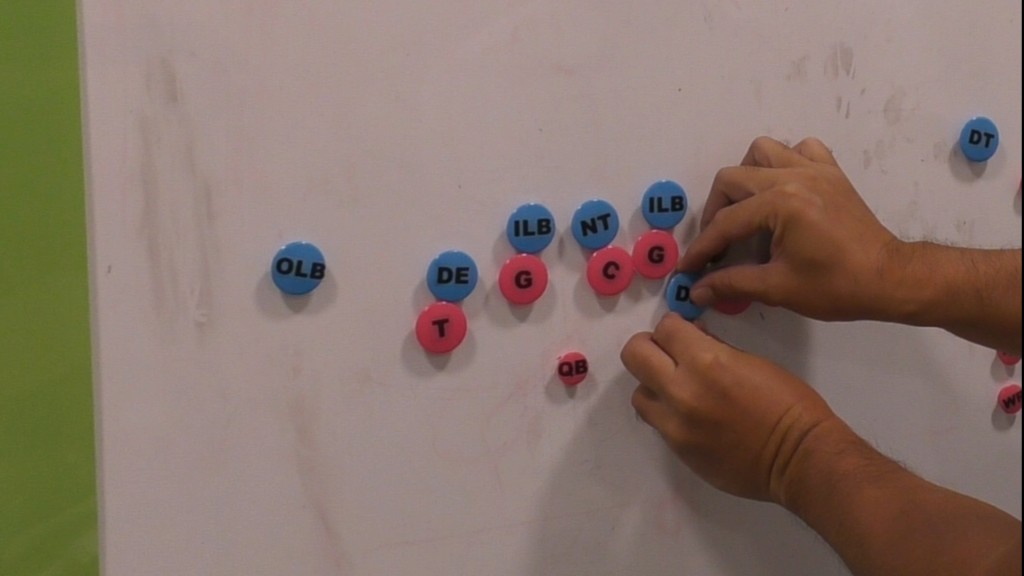
This kind of Defense while watching where the ball is is called “Read Defense.”
In other words, the idea behind this DF formation is that there will be 1 extra DF though DF loses when 2 OF come to 1 DF,
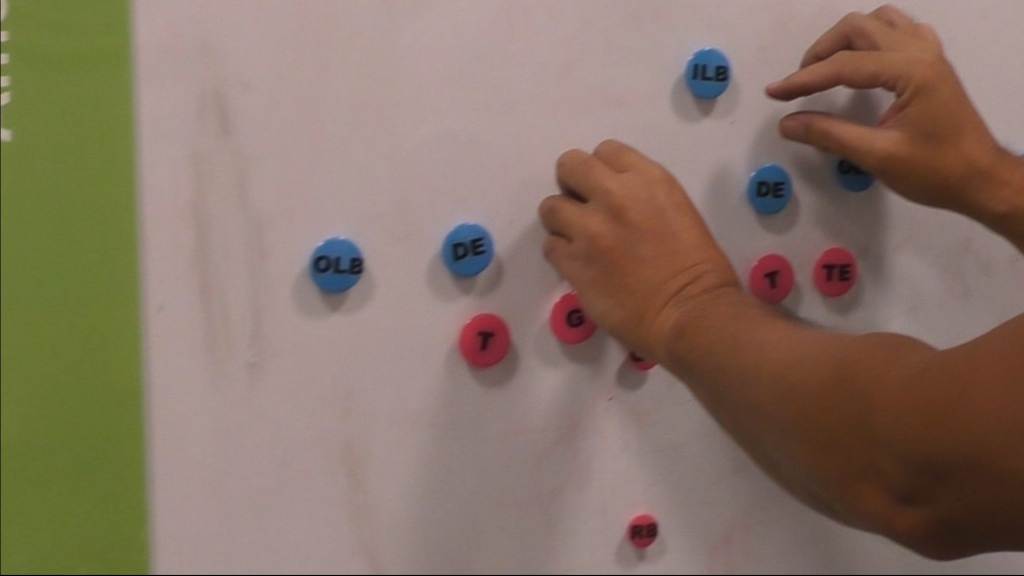
and if it is 1-on-1, DF can always win and go tackle to the Ball carrier.

So, if DF can have many players who are good at 1-on-1 in this area, DF will choose Read Defense because they can make every Run Play no gain.
However, in recent years, as Offensive Linemen (OL) have become larger and more technically advanced, it has become more difficult to develop DF players who can win 1-on-1 every time, no matter how good players they are.
Against such background, the concept of “Gap Defense” which defends the gap by each DF player was born in turn. In Gap Defense, 1 gap is pre-assigned to each DF player to defend.
This player will defend here. This player will defend here. This player will defend here. This player will defend here. This player will defend here. This player will defend here.

In this way, each DF player are assigned which gap he is in charge of, and when RB comes to the gap in charge of, DF player in charge should tackle him. If this player is “Double teamed” here, such player should hold out and these players should stop in this way.
By having 1 player in charge of 1 gap, DF can work together to counter OF who tries to open a big run way somewhere. The idea is that although DL players may not be able to compete with OL 1-on-1, DF would have a better chance of countering OF if they are defending 1 gap per player.
This depends on where DL are positioned, but first of all, if they can win 1-on-1, they would always be positioned right in front of OL, because they can cover on either side. But as it has become increasingly difficult to win 1-on-1 recently, DL have come to think to locate in an advantageous position from the beginning.
Therefore, recently, DL position is slightly out from right in front of OL, as shown here, in many cases. This way, DF can position themselves at the gap each player needs to protect from the start. This technique is called “Shade”.

By doing so, DF are creating an advantageous situation by putting their body at the gap they have to protect before OL come.
So, besides “Read,” there is another way for DF by controlling “Gap”, and these are the primary ways to defend Run Play.
Q: Do you focus on the gap because it would be a potential running path for Running Back (RB)?
Yes. Which gap RB to run is predetermined roughly in scheme of OF, so DF players are to protect the gap to stop RB.
If the assumption is that DL will be able to win 1-on-1, the area where some DL could not win 1-on-1 will be in a terrible situation, but this approach is less likely to lead to such a situation. With “Gap Defense”, it is easy to fill the gap by being in a favorable position first, and even if some DF player gets pushed back a bit, if the nearby DF player cover him, DF can expect to stop Run Play about 3 yards at worst.

Like this way, DF focuses first on stopping Run Play.
Part4-2 How to defend Pass Play
Now, let’s see Pass Defense.
The most obvious way is “man-to-man” Defense. This DF player fixes his eyes on this Offense (OF) player. This DF player, on this OF player. This DF player, on this OF player. This DF player, on this OF player. In this way, DF defends always by man-to-man for all Receivers.

If this Linebacker (LB) watches this Running Back (RB), the rest of DF players only need to think about Run Play. It makes DF very easy to defend. I think DF can stop Run Play quite well.
But, suppose a mismatch is created somewhere on Pass Play. For example, this Receiver is very fast, but DF to mark him is not so fleet of foot, or this DF is good at Pass coverage, but this Receiver is quite big, or on this side, if these Receivers cross, will DF be left behind? Such as.

I think it was all “man-to-man” Defense originally, but “Zone Defense” was created to address such situations.
I will now introduce some typical “Zone Covers.”
Cover 3
“Cover 3” is a Pass cover way in which this player covers 1/3 of the Deep zone, this player also covers 1/3, and this player also covers 1/3, and the other 4 players cover 1/4 of the Under zone each.

Q: How far back from the ball does “Under zone” mean?
It is said to be about 10 to 12 yards like this.

The area deeper than 12 yards from the Line of Scrimmage is called “Deep zone,” while the area in front of that is called “Under zone. However, depending on the situation, it may be 15 yards or so if there is a long distance to go on 3rd down for example, or conversely, it may be shorter.
Cover 3 is the so-called “Zone Defense” concept of covering to Receiver who enters each zone by DF player who is responsible for such zone.

Naturally, Pass Defense is man-to-man basis, since DF players cannot defend without tight mark to the opponent Receiver. DF players cover Receiver who enters their respective responsible zone man-to-man basis.

So, what DF players other than Defensive Line (DL) do is to return firmly to the zone they are in charge of and to cover Receivers who enter their responsible zone. For example, if OF starts the play at their own 30 yards, then of course DF must defend 70-yards range. Any DF players cannot defend 70 yards, because he would be “Superman” if some player can defend 1/3 of the field over 70 yards. So basically, it is impossible.
Of course, DF may think to stop the play before Receivers arrive at their respective point by doing Pass Rush. The idea of Zone Defense is to keep DF players scattered so that they can tackle Receiver as soon as he catches a pass. Therefore, it is often seen that pass is completed relatively easily but Receiver is tackled immediately by DF player while Zone Defense.
The weak point of this Defense is here. And here.

The reason is that these Linebackers (LB) need to be able to stop Run Play as well, and the field is 53 yards wide, so it is difficult to spread these 4 players out to cover.
The other weak points are these connecting points. These are called “Seam.”

As for Deep zone, it is impossible for 3 players to cover 53 yards wide in the first place, so OF throws passes to Seam or to the outside where there are fewer players. In Cover 3, it is common to see OF throwing to these places.
Variation of Cover 3
There are several Variations of Cover 3, for example, to have this player (Defensive End (DE)) added to cover Under zone with 5 players,

or to have 1 LB blitz and to have 3 players cover Under zone as well as 3 players for Deep zone.

Since American Football is played by 11 players, the balance between the number of players pressuring QB and those covering Pass behind may be adjusted in Under zone, even though the same 3 players to cover Deep zone. Or, for example, Cover 3 with “man-to-man” only on both outside is played with different name.
Q:What exactly happens when both outsides are man-to-man?
This is what it looks like in the diagram.
Q:Is DF going to make two man-to-man on both outsides and operate Zone Defense for the rest?
Right.

And, by this way, DF can cover this OF player with these 2 players and this OF player with these 2 players. And the center part can also be covered by this player if Receiver comes to Deep zone. If 2 players can be separated on both outsides, the center area becomes a “9-on-9” fight.

This type of play is called “Cover 7” and is often seen in professional games. Confident Corner Backs (CB) may be positioned like this.

In such cases, they leave both outsides to them and play 9-on-9 in the center area. Sometimes only one side would be separated.
It must be very tough to keep up 1-on-1 for whole the game, because the pressure is on and they have to run all the time. This is determined by the type of play of DF, the type of players team retains, and the approach of Defensive Coordinator (DC).
Part4-3 How to defend Pass Play ② (Cover 2)
Cover 2
“Cover 2” Defense, as the name implies, covers Deep zone with 2 Safety (S) players. Under zone is then covered by 5 players in this manner.

Naturally, it is nearly impossible for 2 players to cover this wide Deep zone, an area more than 10 to 12 yards back from Line of Scrimmage, with only the ability of these 2 players to handle it. Therefore, the basic idea is to have the players in charge of Under zone support these 2 players in charge of Deep zone bearing such heavy responsibility .
How it is done is that for 2 Receivers, the outside DF player (CB) is always positioned on the outside and the inside DF player (OLB) is always positioned on the inside of them. And, when they recognize that it is Pass Play, these DF players are going to narrow Receiver’s running path.

Then, since there are only 2 Receivers on this side, this player (SS) defending this Deep zone only needs to cover this area.

Of course, this area must also be kept in mind, but by narrowing down the priority area from such vast area, it becomes relatively easy to cover.

So the success or failure of Cover 2 will depend on how well these DF players (OLB & CB) can narrow their range.
The areas of Cover 2 Defense where they don’t want to be attacked are Deep zones near the both sidelines, where it is difficult for S to drop back, and the connecting area of the respective areas, often called as “Seam”.

The outermost CB should never allow Receiver to go outside of him. If he allows him to do so, Receiver can catch the pass here. If Receiver comes outside and CB is about to be overtaken, switch to man-to-man basis like this.

By doing so, S automatically covers another Receiver. If Receiver is released to the outside, CB will either cover Receiver by man-to-man basis or come back to Under zone only if S can spread out to the sideline. How to respond if Receiver goes to the outside is determined among the team, and they cover Deep zone following such agreements.
Variation of Cover 2 (Tampa 2)
Cover 2 is inevitably weak in the middle; S are afraid of both sides, so they spread out and drop back, therefore, the middle area would be uncover. If this Receiver penetrates the center in such a situation, it will lead to Touchdown (TD). “Tampa 2”, which is also “2 Deep”, was developed to avoid such situation,

so called because Tampa Bay Buccaneers was the first to do this. This “Mike linebacker (=Inside Linebacker)”, who, as I explained earlier, is a good tackler, is essentially to respond to Run Plays,

but when it comes to Pass Plays, he drops back about 15 yards at full speed. In such cases, Receiver is afraid because he may be hit hard if a large DF player is waiting.
So even if it is the same “Cover 2”, the coverage is a little different for LB. So, for Receiver who comes in like this, this LB will surely follow him. If Tight End (TE) comes here and Receiver comes in like this, each LB marks them tightly like this.

This is often adopted when DF wants to defend aggressively.
As we have seen, even the same “2-High” type of defense can be slightly different depending on how to defend. Though they are often out from TV screen, but I think watching the positions of S will help you understand the Pass coverage by DF much better.
Share this content:
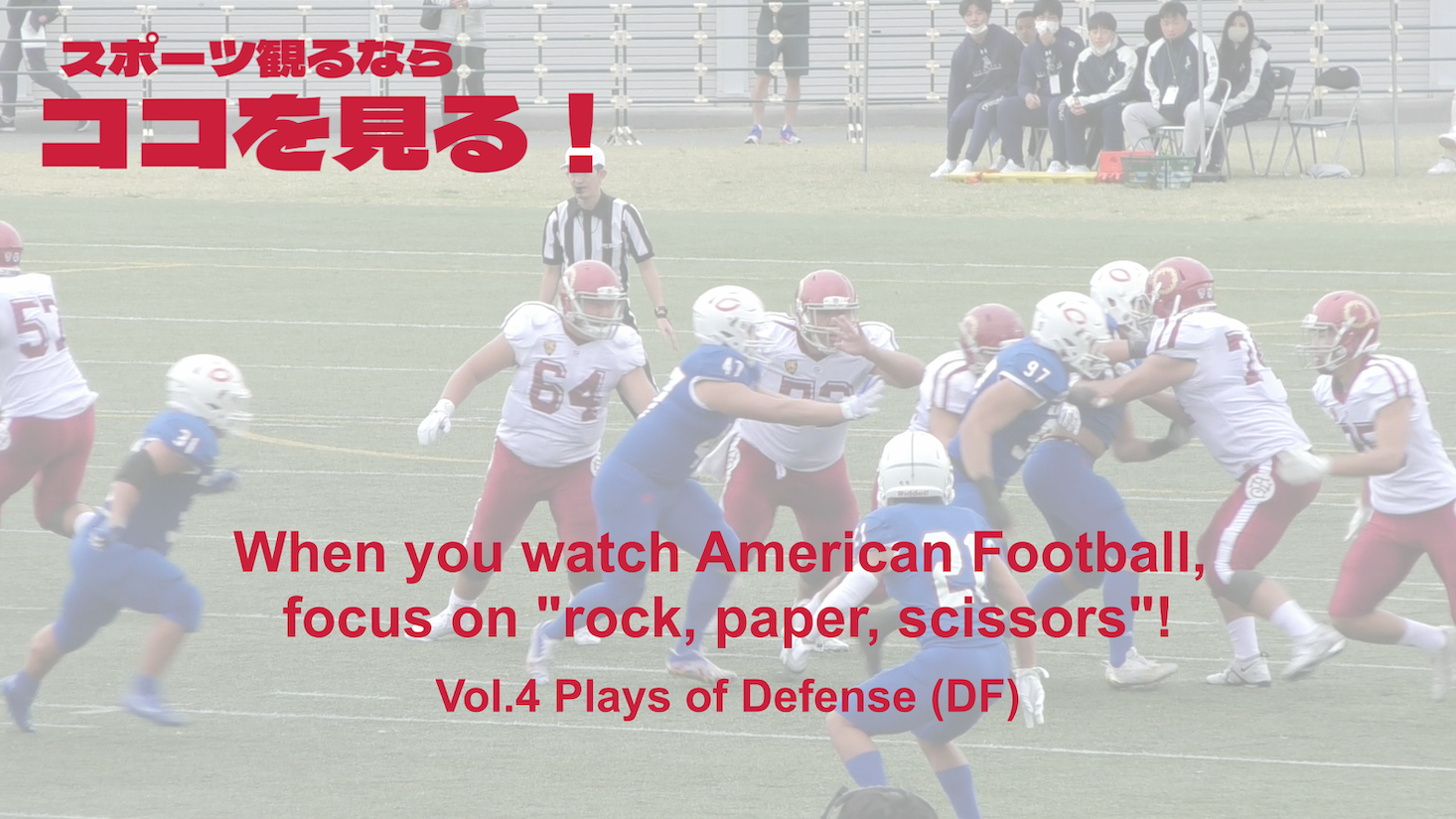
コメントを残す